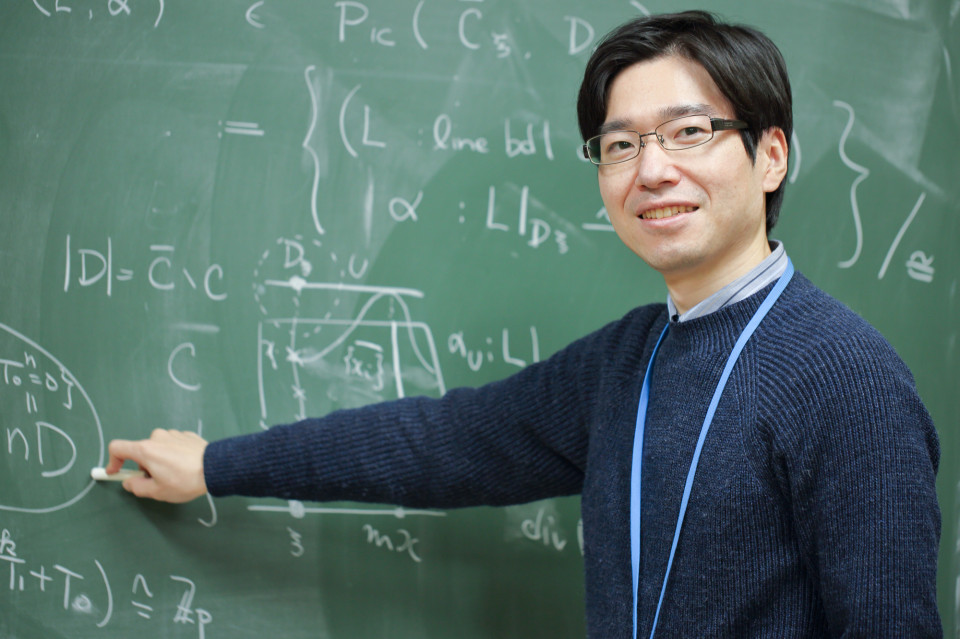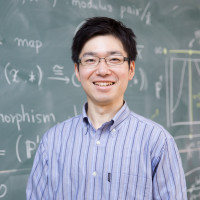Refining Number Theory Geometry through Inspiration from Researchers in Different Fields
Hiroyasu Miyazaki
(Senior Research Scientist, RIKEN Interdisciplinary Theoretical and Mathematical Sciences Program (iTHEMS))
What comes to mind when you hear the term "mathematical researcher"? Is it an image of someone shut away in a room, tirelessly conducting research? While this may be one side of a mathematician's life, discussions and communication with others can also lead to insights and problem-solving breakthroughs. Senior Research Scientist Hiroyasu Miyazaki believes that being in the interdisciplinary environment of iTHEMS has greatly expanded his perspective.
Affiliation and position are as of the interview date: November 2021
Current position: Visiting Scientist, Division of Fundamental Mathematical Science, RIKEN Center for Interdisciplinary Theoretical and Mathematical Sciences (iTHEMS)
(Written and Photographed by Yoshitaka Arafune, science writer)
Number Theory Research Resembles Mountain Climbing
"Research in number theory is similar to mountain climbing," says Hiroyasu Miyazaki. "In the beginning, you don't know where you are, so you feel like you have no choice but to keep climbing. However, as you make progress, you eventually reach a peak, and from there, you can see the bigger picture of what you've struggled through. I enjoy this aspect of number theory, where after the hard work, you're rewarded with a breathtaking view."
In our daily lives, we encounter a multitude of "numbers." For example, "waking up at 7 a.m., a temperature of 9°C, spending 2500 yen at the supermarket." We interact with countless numbers throughout the day. But when asked, "What are numbers?" most people would struggle to answer. Mathematics is the discipline that deeply explores numbers.
There are various systems of numbers. Natural numbers are commonly used to count objects or indicate order. Integers extend this system to include negative numbers, and when fractions are combined with integers, we get rational numbers, which we also use frequently. In the system of integers, numbers exist discretely, like 0, 1, 2, 3. Rational numbers fill in some of the gaps, but they are still discrete. Thus, real numbers, a continuous system of numbers that includes irrational numbers such as π which can't be expressed as rational numbers, were conceived. In the 16th century, the complex number system, which adds imaginary numbers to real numbers, was discovered. Hiroyasu Miyazaki focuses on number theory, the field that studies the properties of integers within these systems of numbers.
Integers are an ancient and basic number system. But being basic doesn't make them simple. In the realm of integers, there are difficult and important problems like the Riemann Hypothesis, Fermat's Last Theorem, and the abc Conjecture.
Solving Integer Problems Using Geometry
Miyazaki originally had a fondness for complex analysis and planned to specialize in complex analysis or complex geometry in the future. However, during his third year of college, he read Jean-Pierre Serre's "A Course in Arithmetic" in a reading seminar, which significantly changed his perspective. "This book also discusses researching number theory using complex function theory in the latter part. I first wanted to read it because it involved complex function theory, but as I read it, I found the initial section on number theory very interesting," recalls Miyazaki.
"Integers seem chaotic and disordered at first. But even though they appear complex and lacking in regularity, close examination often reveals underlying patterns. Ultimately, they often become very simple theories. By continuously seeking a clear, ideal understanding and putting in gritty effort, one can arrive at the correct solution. That's what I find resonates with me," Miyazaki says.
Miyazaki works in arithmetic geometry, a field that uses geometric methods to solve problems with integers. In number theory, researchers investigate whether a particular equation has solutions, and if solutions exist, whether they are finite or infinite. While solutions can be relatively easy to determine in the continuous realm of real numbers by plotting graphs, it is often difficult to mathematically prove the existence of solutions in the discrete world of integers.
"In order to search for solutions to equations within the realm of non-continuous numbers like integers or rational numbers, drawing graphs in the usual sense is mostly useless. However, by utilizing an abstract theory called algebraic geometry, we can obtain generalized spaces (schemes) that are useful even for non-continuous numbers. By using schemes, we can perform operations that appeal to intuition, just like in geometry, even with integer problems," Miyazaki explains.
Methods for investigating the properties of shapes and spaces have been extensively developed throughout history. By incorporating these methods, researchers can extract vast amounts of data that cannot be accessed by directly handling integers, leading to new discoveries.
Arithmetic geometry has become one of the key approaches for solving integer problems. Within this field, Miyazaki's research focuses on motive theory. In arithmetic geometry, it is crucial to study the properties of schemes corresponding to equations, but schemes are complex figures that are not visible to the human eye. Therefore, by using a technique called cohomology, researchers can transform schemes into vector spaces, linear spaces, and matrices, enabling numerical operations. There are various types of cohomology, each capturing different characteristics of schemes.
Aiming for a More General Theory
Motive theory is a theory that considers whether there is a common structure deeper within cohomologies, which at first glance appear to be independent from each other. It was proposed by Alexandre Grothendieck. Motives are entities that unify a wide variety of cohomologies, and through motives, relationships between cohomologies become visible.
The theory of motives was expanded by Vladimir Voevodsky, increasing the range of cohomologies that could be handled. However, Voevodsky's theory is not perfect and there are many cohomologies that cannot be commonly addressed. Miyazaki aims to improve on Voevodsky's theory to expand the scope of what can be handled by the theory of motives.
"There is an advantage to creating motives that allow us to compare different cohomologies," Miyazaki says. "By finding commonalities in different cohomologies, we can understand more essential properties of schemes. Since motive theory aims to unify cohomologies related to a wide variety of theories, knowledge of mathematics from various fields is required. In that sense, it also broadens my interests."
During his stay in France as a doctoral researcher, Miyazaki was reportedly surprised at the differences in the approach to mathematics. "In Japan, when tackling a problem, many people seem to say why it won't work. In contrast, the French mathematicians I encountered were more tenacious, perhaps, and would push forward, believing in their ideals. Just experiencing this difference was worth the trip to France," he reflects.
Currently, Miyazaki is affiliated with iTHEMS, where researchers from various fields such as mathematics, physics, and biology gather. While receiving great stimulation from this environment, he is advancing his research day by day.
"At iTHEMS, I'm always talking to people from various fields, and the boundaries within my own mind are gradually disappearing. I can casually ask questions outside my area of expertise at iTHEMS, and the people I ask seem happy to answer. This experience has greatly expanded my horizons. I am currently researching within the framework of number theory geometry, but it would be great if I could create a theory that drastically changes that framework at some point. For that, I need to take on challenges that ordinary mathematicians might not. I think I have a big advantage in having connections with people that ordinary mathematicians don't usually interact with."


